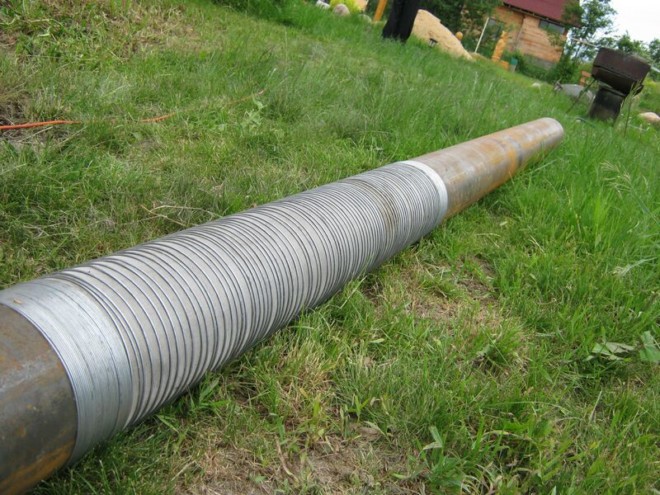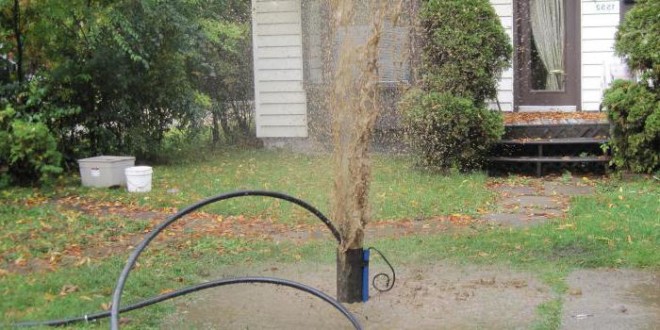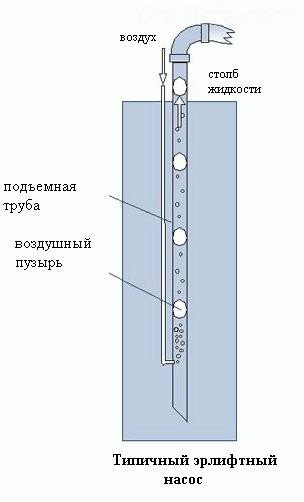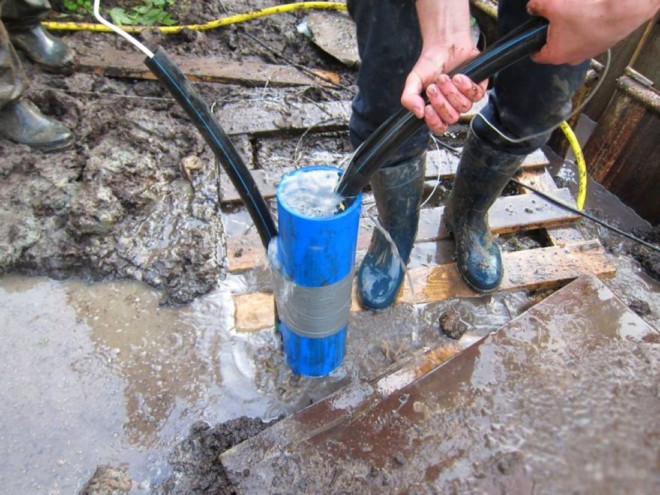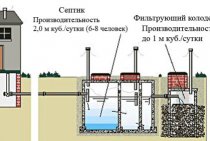well filter
The above indicates that the water in the well is not of high quality, therefore, before use, it must be cleaned using a filter.
In addition to the obvious factors indicating the low quality of water (sand, silt, etc.), it contains a lot of harmful impurities:
- Iron. Its allowable rate is 0.3 mg / l. As the threshold increases, the water becomes cloudy, stains plumbing, and has an unpleasant odor. A well-chosen filter will help to cope with such a problem.
- Hydrogen sulfide. Its presence is indicated by an unpleasant odor. You can not drink such water: it can be poisonous.
- Increased mineralization. The salt content in drinking water should not exceed 1000 mg/l. Otherwise, the liquid will be salty.
- Nitrates. They can negatively affect the heart and blood vessels. Their norm is 45 mg/l for adults and 10 mg/l for children.
- Bacteria and viruses. They can cause various pathologies. These harmful microorganisms enter the water from the environment.
A well-chosen filter will help protect against problems caused by poor water quality. Especially relevant is its installation in water pipes originating in wells prone to frequent clogging.
The filter must be changed regularly. The period of its correct functioning directly depends on the quality of the water. It increases with regular cleaning of the water source.
Purification can be carried out not only from various debris (for example, sand or silt), but also from harmful microorganisms and substances that affect water quality.
Such events cannot be carried out independently. For this, specialists from the sanitary and epidemiological station should be involved. At the same time, water from the well will not be drinkable for a certain time.
The laws of Archimedes in the service of a summer resident
This method allows you to independently clean the well from sand and silt, resorting to the laws of Archimedes known for several thousand years. The well shaft is a kind of vessel with liquid. It is required to lower a pipe into it, into the bottom of which air is supplied under considerable pressure by means of a compressor. Due to this, an air-foam mixture appears in the pipe. Thus, the water column rises through the pipe and exits.
The cleaning of the well by the compressor should be controlled. Blowing stops when the water runs out. Together with water, all the garbage present in it rises through the pipe.
Blockage Prevention
To prevent the well from silting up, the following rules for operating the well source should be followed:
- The used electric pump and water consumption must correspond to the flow rate of the well, with significantly higher rates of the latter, the likelihood of stagnation in the source and, accordingly, siltation increases.
- The immersion height of the electric pump from the bottom level must match the recommendations given in the instructions.
- In no case should submersible vibration pumps be used for water intake - in addition to low productivity, they create vibrations that contribute to the compaction of sandy-silt deposits in the bottom area.
- Interruption of source operation for more than two months should be avoided. If possible, pump out at least 100 liters of water during this period.
- In order to avoid the penetration of surface and ground waters, dirt into the well channel, it is necessary to use a cap or a cover that covers the end of the upper casing pipe.

Rice. 15 Cleaning work
When solving the problem of how to clean a well with their own hands, they use various methods using electric pumps, compressors, mechanical devices in the form of bailers or heavy blanks. When carrying out work on your own, it is better to start with the simplest operations - the source is cleaned by pumping with a vibration pump or a compressor, if the result is negative, you can switch to the technology of lifting the soil with a bailer or hydraulic shocks.If these operations have not brought results, you can always use the help of specialized drilling companies that are highly likely to cope with the task in a short time.
Preventive measures
It is almost impossible to prevent the contamination of wells with silt and sand, since these materials carry groundwater with them, and the violation of the integrity of the soil structure is an excellent place for their accumulation. But it is not difficult to protect yourself from various debris entering the mine. To do this, you must carefully close it. This can be done with various materials, such as tin sheets.
If the mine has a shallow depth, then it is possible to finish the mine with wood, concrete, etc. Often, ordinary wells act as a place for water intake. They are finished with reinforced concrete rings.
It should be understood that even timely preventive measures do not give a 100% guarantee that the well will not be clogged. They only allow you to increase the time between cleaning. In other words, a well-maintained well can be cleaned once every 2 years, and an unimproved well, sometimes several times per season.
Clean and replace filters in a timely manner, and then you will be provided with clean and tasty water all year round. Moreover, carrying out cleaning activities will not require much effort, time and money from you. Surely one of the above five ways is perfect for you.
Cleaning with a vibration pump
Cleaning of wells for water can be carried out using a conventional or special pump designed to pump out a mixture of sand and debris with small stones. Cleaning the well from sand in this way is quite simple. To carry it out, you must perform the following steps:
- lower the hydraulic machine to the bottom and start it;
- all small debris at the bottom will fall into the water supply and will be brought out; a similar method is also acceptable for those people who do not know how to clean the well from clay;
- during the cleaning process, it is required to periodically pass clean water through the system;
- it will not be possible to quickly clean the well with your own hands, because during operation the pump housing can become very hot, and it needs to be allowed to rest.
Cleaning wells with a standard pumping unit of the “Kid” type is permissible if their depth does not exceed 40 meters.
Method 5 using an airlift
How to clean a well in the country from sand and silt using an airlift? The method consists in using the law of Archimedes. What exactly is a well? This is a container of water. A water-lifting pipe is placed in it, into the lower part of which compressed air is supplied by means of an air compressor. A mixture of air and foam is formed in the pipe. The water column presses from below on the riser pipe - the process begins, it must be controlled so that the water in the well being cleaned does not run out.
Since the bottom of the pipe is located almost on the sand, sand with water rises and is absorbed by the riser pipe. The task of the person involved in cleaning is to monitor the water level in the well.
Cleaning with an airlift pump is also an effective way. Compressed air is supplied under pressure, at the bottom of the pipe, silt, water, small stones rise, are absorbed by the pipe and are pushed to the surface
As a rule, the wells in the areas are shallow, and a standard vibratory pump or bailer is suitable for cleaning. If the depth of the well is significant, you can try the mechanized cleaning method. When using a fire truck hose, cleaning the well will be very fast, but it is expensive. Unfortunately, this method often leads to damage, and this entails additional costs. If the main source of water in your country house is a well, choose a cleaning method that is convenient for you and periodically clean it so that there are no interruptions in the water supply, because water in the country is the main condition for a comfortable stay.
The main causes of failure
Before deciding how to flush the well, you need to identify the cause of the breakdown. A lot of them. The most common are:
- non-seasonal use;
- mistakes made during the drilling process;
- change in the direction of groundwater flow;
- lack of protection against debris entering the mouth;
- incorrect operation of the pumping mechanism and untimely maintenance of hydraulic machines responsible for water supply.
When deciding how to clean the well from sand, stones and other things that impede water supply, you need to consider the type of well. It can be with or without a filter device. In any case, cleaning the well can be carried out in three ways:
- washing;
- pumping;
- purge.
Do-it-yourself well cleaning can be done much faster if there is no filter in its design. This is due to the fact that the equipment for cleaning activities can be lowered to the very bottom.
Of the three cleaning methods proposed above, pumping is the most accessible. It is most often taken into account by people who are thinking about how to clean the well from sand.
How to choose the right cleaning option
It can be difficult even for a specialist to determine exactly why the well flow rate has fallen. As a rule, pollution is complex. If the pump "drives" sand with water, this does not mean that the soil is not silted.
When cleaning the well with your own hands, you should be patient. It may be necessary to apply successively several methods and try hard before a satisfactory result is obtained.
We recommend starting with the simplest: pumping with a vibration pump. If pumping did not help, proceed to flushing. We start with flushing if the source is almost dry. To scoop out sand, if there is a lot of it at the bottom, a bailer will help.
But it cannot be used for plastic casing, only for steel. For polymer barrels, we use only bubbling. If there is neither sand nor water in the steel casing, we turn to the water hammer technology.
This, of course, if the aquifer itself has not dried up. Renting a washing machine, of course, costs a penny, but the cleaning efficiency is noticeably higher than when using artisanal methods.
Different types of wells and the causes of their clogging
It should be noted that all types of wells, depending on the depth of drilling, are divided into three classes: Abyssinian, sandy and artesian.
Modern Abyssinian wells of shallow occurrence up to 30 m below the ground are made of a light casing string in the form of plastic pipes of various diameters; due to its low weight, with proper installation, it is not lowered to the bottom of an underground water reservoir. Therefore, water from a properly installed Abyssinian well has a small amount of sand, dissolved clay impurities and, accordingly, rarely needs to be cleaned.
Another nuance of the Abyssinian wells is the frequent use of a pipeline made of low-pressure polyethylene pipes (HDPE) of various lengths as a casing string. This allows you to clean the filters and the area below by simply removing the tubing from the borehole.
In deep artesian wells, the bottomhole (bottom area) of which is located at a distance of 100 m and below from the surface of the earth, a casing string is installed on a dense calcareous bottom - thanks to this, the well practically does not clog, and its service life without cleaning works reaches 50 years .
The most problematic from the point of view of operation are wells on sand, the optimal depth of which varies in the range of 30 - 70 m. sand and clay not only get into the water, but also in the process of operation they gradually clog the holes of the filters, settling in the face with a layer constantly increasing in height.
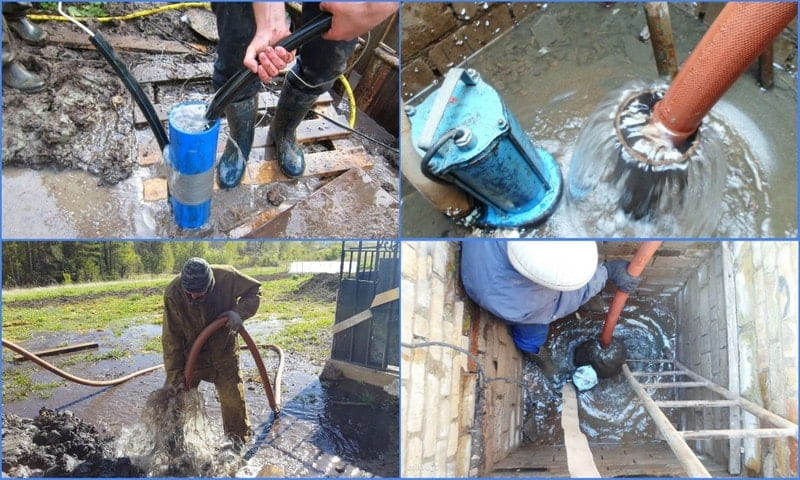
In addition to natural inevitable processes, other reasons for the rapid clogging of sand wells are:
- Technical errors during well construction, for example, an incorrectly selected filter at the end of the casing. The fact is that any well in the sand has a certain size of sand particles at the bottom - this is taken into account when installing the final filter. If its cells are too large, sand will accumulate in the bottomhole, the height of the sand layer will increase and it will block all channels of water supply - the flow rate will decrease and the well will have to be cleaned.
- Also, unscrupulous drillers can put into operation a well source with fine dispersion sand to the user - such a well will silt up in 1-2 years and no cleaning will help here.
- Interruptions in operation often cause the well to become silted due to the lack of flow as a result of sedimentation and compaction of sand and clay particles suspended in water. A similar situation occurs in a high-performance well with a low volume of water taken.
- The use of vibration electric pumps leads to the fact that, as a result of constant vibrations, bottom sediments from clay and sand are compacted and prevent water from entering the borehole channel.
- Incorrect placement of the electric pump also leads to silting, if it is suspended too far from the bottom, stagnation occurs in the face - as a result, sand and clay particles calmly settle to the bottom and gradually clog the filter holes.
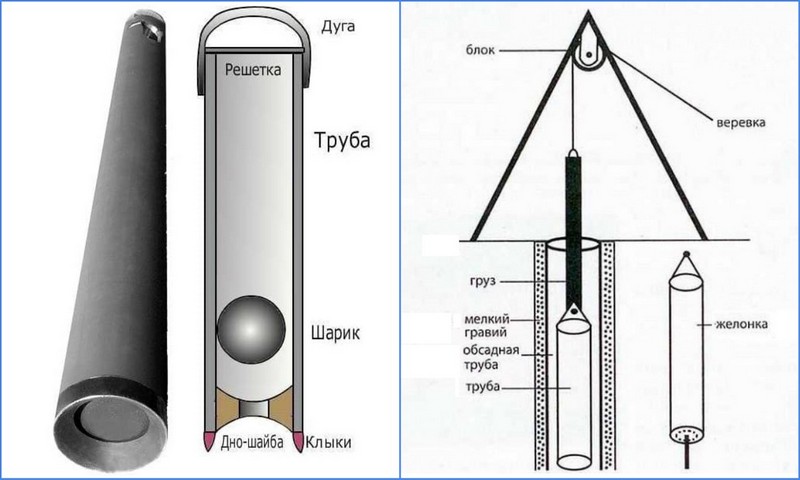
How to prevent clogging of the well
There are no "eternal" wells for water supply. Unfortunately, sooner or later, the owner of an individual water source will run into problems. It’s bad if the aquifer has dried up, you have to drill again or deepen the existing development. This is difficult and very costly.
It is another matter if a clogging of the well has happened - it is easier and cheaper to prevent than to “treat”.
Extending the service life of the source contributes to the observance of several rules of operation:
- Strictly adhere to the chosen drilling technology. Carefully monitor the tightness of the casing and the integrity of the filter.
- Immediately after completion of drilling operations, flush the source until clean water appears.
- Protect the well from the penetration of surface water and pollution by installing a caisson, head. As a temporary solution, simply seal the top of the casing.
- Prior to the start of operation, it is correct to select and install a submersible pump at the required height, always taking into account the flow rate of the well.
- It is advisable not to use a vibration pump to supply water. Vibrating in the casing, it, depending on the type of soil, to a greater or lesser extent provokes the penetration of sand into the well or contributes to siltation of the adjacent soil. A cheap and simple vibrator can be used for a short time; a centrifugal pump is needed for permanent operation.
- The well should not stand idle without parsing water. The ideal mode of operation is the daily pumping of several tens or hundreds of liters of water. It is provided if people permanently live in the house. If this is not possible, you should regularly, at least once every 2 months, pump out at least 100 liters of water from the well.
The implementation of these recommendations, of course, will not allow to avoid clogging of the well in the future. However, it will delay this trouble by providing the maximum possible resource for effective operation for this source.
The correct arrangement of the well is the key to its longevity. It is necessary to install a special head on the casing pipe, which seals it and serves for reliable installation of equipment
This is interesting: How to properly insulate the attic floor with your own hands: we explain carefully
Method 2 cleaning the well with a bailer
If the well is slightly clogged, and at the same time shallow in itself, a bailer can be used. In other cases, its application will be ineffective. If the depth is within 30m or more, you will also need a winch, and this method of cleaning will require considerable effort from two strong men.
Bailer - a piece of pipe on a cable with a mesh in the upper part and a hole in the bottom. It sinks to the bottom, then rises to a height of 0.5 m and drops sharply. Water is drawn inside, inside the cylinder there is a ball of metal, which after a couple of seconds rises, and then falls and closes the hole. Such a cycle of raising and lowering is repeated three or four times, then the bailer is raised and cleared of sand. To make it more convenient, you can use a tripod. At a time, about 0.5 kg of sand enters the cylinder, so by cleaning in this way, you can find out how quickly the well becomes clogged.
Photo and diagram of the bailer device. Reviews about this method of cleaning the well are both positive and negative. For some, this method of cleaning seems to be very time-consuming and inefficient, someone only uses it. If you can make a bailer yourself, such cleaning will not require extra expenses, and this is already a plus
A bailer with a ball valve can be made independently or bought ready-made in a store.
This is interesting: Design of a bedroom with a loggia - we learn in detail
Influence of well type on clogging
The clogging of the well, which reduces its productivity, depends to the greatest extent on its type. Artesian species are practically not affected by clogging, the casing string of which is located in the area of solid calcareous rocks - this makes it impossible for suspended impurities to enter the water that affect its functioning.
Shallow Abyssinian wells, in which the casing is located in the aquifer, also produce clean water with a low amount of suspended particles - this significantly reduces the likelihood of clogging.
Wells on sand, the casing string of which rests on a sandy-clay bottom, are most prone to clogging. At the same time, the size of sand fractions has a high impact on the likelihood of blockages - the smaller they are, the more often the well needs to be cleaned. The sand particle size factor is taken into account when drilling - if the sand is finely dispersed, the installation of the casing is abandoned altogether or the borehole channel is deepened to an aquifer with a more suitable low-dispersion soil.

Fig 2. Structural arrangement of downhole PVC-U filters
Conclusions and useful video on the topic
In conclusion, a useful video that shows step by step the available technique for flushing a clogged well:
Note that cleaning a well from sand and silt can be a very difficult task. And it’s not a fact that it will be possible to do it on our own at all.
And carelessly wielding mechanical projectiles, you can generally cause significant damage to the water source
At the same time, there is a special technique that very effectively and to a large extent restores the characteristics of wells.
Do you have personal experience in well cleaning on site? Want to share actionable methods or ask questions about a topic? Please leave a feedback form below.
